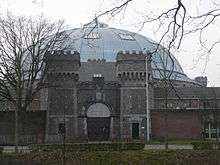Koepelgevangenis (Breda)

The Koepelgevangenis is a former prison in Breda, Netherlands, constructed in 1886,[1] best known as the prison where convicted World War II collaborators were held captive.[2]
History
The Koepelgevangenis was built from 1882 to 1886, having been designed by Johan Frederik Metzelaar, who also designed a similar prison at Arnhem. The prison was constructed as a panopticon, as invented in 1791 by Jeremy Bentham. This allowed the guards to continuously watch the prisoners from the centre of the building.
The Koepelgevangenis complex was designated a national monument in 2001 and housed a women's prison until 2013. The women were transferred to the Ter Peel institution in Horst aan de Maas. In that year, it was announced that the entire prison would be closed due to budget cutbacks. The first department was closed in 2014 and the entire complex closed its doors at the start of 2016.[3]
Layout
The complex consists of:
- fortified gate
- separate church building
- a jail and the former Breda court building, designed by Willem Cornelis Metzelaar, son of Koepelgevangenis designer Johan Frederik Metzelaar.
- the Koepelgevangenis itself
See also
- Koepelgevangenis (Arnhem), also designed by Johan Frederik Metzelaar
- Koepelgevangenis (Haarlem), designed by Willem Cornelis Metzelaar
References
- ↑ Bank, Jan Th. M.; Mathijsen, Marita (2006). Nederland in de negentiende eeuw. Bert Bakker. p. 178. ISBN 9789035129504. Retrieved 2 May 2012.
- ↑ Smits, H. (2008). Strafrechthervormers en Hemelbestormers: Opkomst en Teloorgang Van de Coornhert-Liga. Amsterdam UP. p. 59. ISBN 9789052602974. Retrieved 2 May 2012.
- ↑ BN De Stem, 22 maart 2013
External links
- De Koepel gevangenis: cellengebouw (koepel) in Breda at rijksmonumenten.nl (in Dutch)